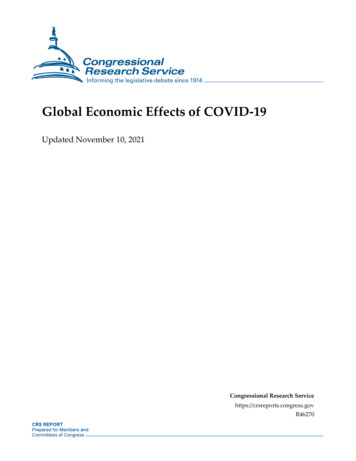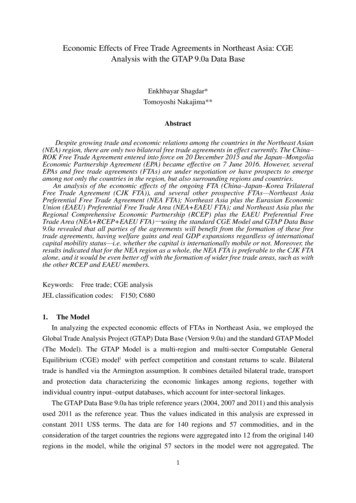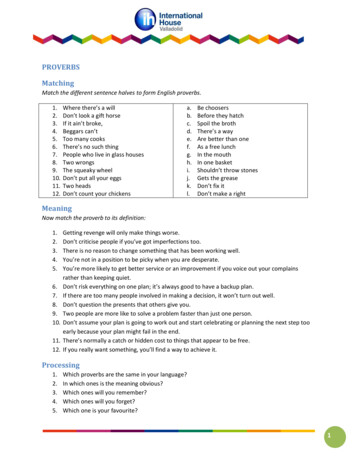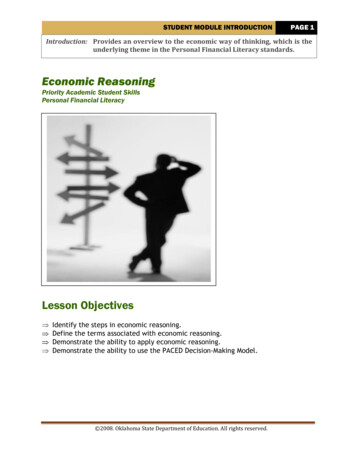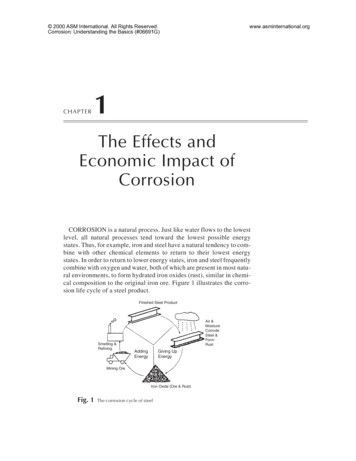
Transcription
2000 ASM International. All Rights Reserved.Corrosion: Understanding the Basics (#06691G)CHAPTERwww.asminternational.org1The Effects andEconomic Impact ofCorrosionCORROSION is a natural process. Just like water flows to the lowestlevel, all natural processes tend toward the lowest possible energystates. Thus, for example, iron and steel have a natural tendency to combine with other chemical elements to return to their lowest energystates. In order to return to lower energy states, iron and steel frequentlycombine with oxygen and water, both of which are present in most natural environments, to form hydrated iron oxides (rust), similar in chemical composition to the original iron ore. Figure 1 illustrates the corrosion life cycle of a steel product.Finished Steel ProductSmelting &RefiningAir &MoistureCorrodeSteel &FormRustAddingEnergyGiving UpEnergyMining OreIron Oxide (Ore & Rust)Fig. 1The corrosion cycle of steel
2000 ASM International. All Rights Reserved.Corrosion: Understanding the Basics (#06691G)2www.asminternational.orgCorrosion: Understanding the BasicsThe Definition of CorrosionCorrosion can be defined in many ways. Some definitions are verynarrow and deal with a specific form of corrosion, while others are quitebroad and cover many forms of deterioration. The word corrode is derived from the Latin corrodere, which means “to gnaw to pieces.” Thegeneral definition of corrode is to eat into or wear away gradually, as ifby gnawing. For purposes here, corrosion can be defined as a chemicalor electrochemical reaction between a material, usually a metal, andits environment that produces a deterioration of the material and its properties.The environment consists of the entire surrounding in contact with thematerial. The primary factors to describe the environment are the following: (a) physical state—gas, liquid, or solid; (b) chemical composition—constituents and concentrations; and (c) temperature. Other factors canbe important in specific cases. Examples of these factors are the relativevelocity of a solution (because of flow or agitation) and mechanicalloads on the material, including residual stress within the material. Theemphasis in this chapter, as well as in other chapters in this book, is onaqueous corrosion, or corrosion in environments where water is present. The deterioration of materials because of a reaction with hot gases,however, is included in the definition of corrosion given here.To summarize, corrosion is the deterioration of a metal and is causedby the reaction of the metal with the environment. Reference to marinecorrosion of a pier piling means that the steel piling corrodes because ofits reaction with the marine environment. The environment is airsaturated seawater. The environment can be further described by specifying the chemical analysis of the seawater and the temperature and velocity of the seawater at the piling surface.When corrosion is discussed, it is important to think of a combinationof a material and an environment. The corrosion behavior of a materialcannot be described unless the environment in which the material is tobe exposed is identified. Similarly, the corrosivity or aggressiveness ofan environment cannot be described unless the material that is to be exposed to that environment is identified. In summary, the corrosion behavior of the material depends on the environment to which it is subjected, and the corrosivity of an environment depends on the materialexposed to that environment.It is useful to identify both natural combinations and unnatural combinations in corrosion. Examples of natural or desirable combinations ofmaterial and environment include nickel in caustic environments, leadin water, and aluminum in atmospheric exposures. In these environments, the interaction between the metal and the environment does not
2000 ASM International. All Rights Reserved.Corrosion: Understanding the Basics (#06691G)www.asminternational.orgThe Effects and Economic Impact of Corrosion3usually result in detrimental or costly corrosion problems. The combination is a natural combination to provide good corrosion service.Unnatural combinations, on the other hand, are those that result in severe corrosion damage to the metal because of exposure to an undesirable environment. Examples of unnatural combinations include copperin ammonia solutions, stainless steel in chloride-containing environments (e.g., seawater), and lead with wine (acetic acid in wine attackslead). It has been postulated that the downfall of the Roman Empire canbe attributed in part to a corrosion problem, specifically the storage ofwine in lead-lined vessels. Lead dissolved in the wine and consumed bythe Roman hierarchy resulted in insanity (lead poisoning) and contributed to the subsequent eventual downfall. Another anecdote regardinglead and alcoholic beverages dates back to the era of Benjamin Franklin. One manifestation was the “dry bellyache” with accompanying paralysis, which was mentioned by Franklin in a letter to a friend. Thismalady was actually caused by the ingestion of lead from corroded leadcoil condensers used in making brandy. The problem became so widespread that the Massachusetts legislature passed a law in the late 1700sthat outlawed the use of lead in producing alcoholic beverages.The Effects of CorrosionThe effects of corrosion in our daily lives are both direct, in that corrosion affects the useful service lives of our possessions, and indirect, inthat producers and suppliers of goods and services incur corrosioncosts, which they pass on to consumers. At home, corrosion is readilyrecognized on automobile body panels, charcoal grills, outdoor furniture, and metal tools. Preventative maintenance such as painting protects such items from corrosion. A principal reason to replace automobile radiator coolant every 12 to 18 months is to replenish the corrosioninhibitor that controls corrosion of the cooling system. Corrosion protection is built into all major household appliances such as water heaters, furnaces, ranges, washers, and dryers.Of far more serious consequence is how corrosion affects our livesduring travel from home to work or school. The corrosion of steel reinforcing bar (rebar) in concrete can proceed out of sight and suddenly (orseemingly so) result in failure of a section of highway, the collapse ofelectrical towers, and damage to buildings, parking structures, andbridges, etc., resulting in significant repair costs and endangering public safety. For example, the sudden collapse because of corrosion fatigue of the Silver Bridge over the Ohio River at Point Pleasant, OH in1967 resulted in the loss of 46 lives and cost millions of dollars.
2000 ASM International. All Rights Reserved.Corrosion: Understanding the Basics (#06691G)4www.asminternational.orgCorrosion: Understanding the BasicsPerhaps most dangerous of all is corrosion that occurs in major industrial plants, such as electrical power plants or chemical processingplants. Plant shutdowns can and do occur as a result of corrosion. This isjust one of its many direct and indirect consequences. Some consequences are economic, and cause the following:······Replacement of corroded equipmentOverdesign to allow for corrosionPreventive maintenance, for example, paintingShutdown of equipment due to corrosion failureContamination of a productLoss of efficiency—such as when overdesign and corrosion productsdecrease the heat-transfer rate in heat exchangers· Loss of valuable product, for example, from a container that has corroded through· Inability to use otherwise desirable materials· Damage of equipment adjacent to that in which corrosion failure occursStill other consequences are social. These can involve the following issues:· Safety, for example, sudden failure can cause fire, explosion, releaseof toxic product, and construction collapse· Health, for example, pollution due to escaping product from corrodedequipment or due to a corrosion product itself· Depletion of natural resources, including metals and the fuels used tomanufacture them· Appearance as when corroded material is unpleasing to the eyeOf course, all the preceding social items have economic aspects also(see the discussion that follows, “Economic Impact of Corrosion”).Clearly, there are many reasons for wanting to avoid corrosion.The Many Forms of CorrosionCorrosion occurs in several widely differing forms. Classification isusually based on one of three factors:· Nature of the corrodent: Corrosion can be classified as “wet” or“dry.” A liquid or moisture is necessary for the former, and dry corrosion usually involves reaction with high-temperature gases.· Mechanism of corrosion: This involves either electrochemical or direct chemical reactions.
2000 ASM International. All Rights Reserved.Corrosion: Understanding the Basics (#06691G)www.asminternational.orgThe Effects and Economic Impact of Corrosion5· Appearance of the corroded metal: Corrosion is either uniform andthe metal corrodes at the same rate over the entire surface, or it is localized, in which case only small areas are affected.Classification by appearance, which is particularly useful in failureanalysis, is based on identifying forms of corrosion by visual observation with either the naked eye or magnification. The morphology of attack is the basis for classification. Figure 2 illustrates schematicallysome of the most common forms of corrosion.Eight forms of wet (or aqueous) corrosion can be identified based onappearance of the corroded metal. These are:· Uniform or general corrosion· Pitting corrosion· Crevice corrosion, including corrosion under tubercles or deposits,filiform corrosion, and poultice corrosion· Galvanic corrosion· Erosion-corrosion, including cavitation erosion and fretting corrosion· Intergranular corrosion, including sensitization and exfoliation· Dealloying, including dezincification and graphitic corrosion· Environmentally assisted cracking, including stress-corrosion cracking, corrosion fatigue, and hydrogen damageIn theory, the eight forms of corrosion are clearly distinct; in practicehowever, there are corrosion cases that fit in more than one category.Other corrosion cases do not appear to fit well in any of the eight categories. Nevertheless, this classification system is quite helpful in the studyLoadMore noblemetalNo mentErosionFrettingTensile stressPittingFig. ncrackingSchematics of the common forms of corrosionMetal ornonmetalCreviceCyclic stressCorrosionfatigue
2000 ASM International. All Rights Reserved.Corrosion: Understanding the Basics (#06691G)www.asminternational.org6Corrosion: Understanding the ttingStress-corrosioncrackingExfoliationCorrosion fatigueDealloyingFig. 3Macroscopic versus microscopic forms of localized corrosionof corrosion problems. Detailed information on these eight forms ofcorrosion can be found in Chapter 4.Completeness requires further distinction between macroscopicallylocalized corrosion and microscopic local attack. In the latter case, theamount of metal dissolved is minute, and considerable damage can occur before the problem becomes visible to the naked eye. Macroscopicforms of corrosion affect greater areas of corroded metal and are generally observable with the naked eye or can be viewed with the aid of alow-power magnifying device. Figure 3 classifies macroscopic and microscopic forms of localized corrosion.Methods to Control CorrosionThere are five primary methods of corrosion control:·····Material selectionCoatingsInhibitorsCathodic protectionDesignEach is described briefly here and in more detail in subsequent chapters.Material SelectionEach metal and alloy has unique and inherent corrosion behavior thatcan range from the high resistance of noble metals, for example, gold
2000 ASM International. All Rights Reserved.Corrosion: Understanding the Basics (#06691G)www.asminternational.orgThe Effects and Economic Impact of Corrosionand platinum, to the low corrosion resistance of active metals, for example, sodium and magnesium. Furthermore, the corrosion resistance of ametal strongly depends on the environment to which it is exposed, thatis, the chemical composition, temperature, velocity, and so forth.The general relation between the rate of corrosion, the corrosivity ofthe environment, and the corrosion resistance of a material is:corrosivity of environment» rate of corrosive attackcorrosion resistance of metalFor a given corrosion resistance of the material, as the corrosivity ofthe environment increases, the rate of corrosion increases. For a givencorrosivity of the environment, as the corrosion resistance of the material increases, the rate of corrosion decreases. Often an acceptable rateof corrosion is fixed and the challenge is to match the corrosion resistance of the material and the corrosivity of the environment to be at orbelow the specified corrosion rate. Often there are several competingmaterials that can meet the corrosion requirements, and the material selection process becomes one of determining which of the candidate materials provides the most economical solution for the particular service.Consideration of corrosion resistance is often as important in the selection process as the mechanical properties of the alloy. A common solution to a corrosion problem is to substitute and alloy with greater corrosion resistance for the alloy that has corroded.CoatingsCoatings for corrosion protection can be divided into two broadgroups—metallic and nonmetallic (organic and inorganic). With eithertype of coating the intent is the same, that is, to isolate the underlyingmetal from the corrosive media.Metallic Coatings. The concept of applying a more noble metal coating on an active metal takes advantage of the greater corrosive resistance of the noble metal. An example of this application is tin-platedsteel. Alternatively, a more active metal can be applied, and in this casethe coating corrodes preferentially, or sacrificially, to the substrate. Anexample of this system is galvanized steel, where the sacrificial zinccoating corrodes preferentially and protects the steel.Organic Coatings. The primary function of organic coatings in corrosion protection is to isolate the metal from the corrosive environment.In addition to forming a barrier layer to stifle corrosion, the organiccoating can contain corrosion inhibitors. Many organic coating formulations exist, as do a variety of application processes to choose from fora given product or service condition.7
2000 ASM International. All Rights Reserved.Corrosion: Understanding the Basics (#06691G)8www.asminternational.orgCorrosion: Understanding the BasicsInorganic coatings include porcelain enamels, chemical-setting silicate cement linings, glass coatings and linings, and other corrosionresistant ceramics. Like organic coatings, inorganic coatings for corrosion applications serve as barrier coatings. Some ceramic coatings,such as carbides and silicides, are used for wear-resistant and heatresistant applications, respectively.InhibitorsJust as some chemical species (e.g., salt) promote corrosion, otherchemical species inhibit corrosion. Chromates, silicates, and organicamines are common inhibitors. The mechanisms of inhibition can bequite complex. In the case of the organic amines, the inhibitor is adsorbedon anodic and cathodic sites and stifles the corrosion current. Other inhibitors specifically affect either the anodic or cathodic process. Still others promote the formation of protective films on the metal surface.The use of inhibitors is favored in closed systems where the necessaryconcentration of inhibitor is more readily maintained. The increaseduse of cooling towers stimulated the development of new inhibitor/water-treatment packages to control corrosion and biofouling.Inhibitors can be incorporated in a protective coating or in a primerfor the coating. At a defect in the coating, the inhibitor leaches from thecoating and controls the corrosion.Cathodic ProtectionCathodic protection suppresses the corrosion current that causes damage in a corrosion cell and forces the current to flow to the metal structure to be protected. Thus, the corrosion or metal dissolution is prevented. In practice, cathodic protection can be achieved by twoapplication methods, which differ based on the source of the protectivecurrent. An impressed-current system uses a power source to force current from inert anodes to the structure to be protected. A sacrificial-anode system uses active metal anodes, for example, zinc or magnesium,which are connected to the structure to provide the cathodic-protectioncurrent.DesignThe application of rational design principles can eliminate many corrosion problems and greatly reduce the time and cost associated withcorrosion maintenance and repair. Corrosion often occurs in deadspaces or crevices where the corrosive medium becomes more corrosive. These areas can be eliminated or minimized in the design process.Where stress-corrosion cracking is possible, the components can be designed to operate at stress levels below the threshold stress for cracking.
2000 ASM International. All Rights Reserved.Corrosion: Understanding the Basics (#06691G)www.asminternational.orgThe Effects and Economic Impact of Corrosion9Where corrosion damage is anticipated, design can provide for maximum interchangeability of critical components and standardization ofcomponents. Interchangeability and part standardization reduce the inventory of parts required. Maintenance and repair can be anticipated,and easy access can be provided. Furthermore, for the large items thatare critical to the entire operation, such as primary pumps or large fans,redundant equipment is installed to permit maintenance on one unitwhile the other is operating. These practices are a sampling of rationaldesign principles.Opportunities in Corrosion ControlThe massive costs of corrosion provide many opportunities to users,manufacturers, and suppliers. Opportunities exist to reduce corrosioncosts and the risks of failure, and to develop new, expanded markets.Examples of these opportunities and the means to implement a programto capitalize on the opportunities are presented in Table 1.The costs of corrosion vary considerably from industry to industry;however, substantial savings are achievable in most industries. The firststep in any cost-reduction program is to identify and quantify the present costs of corrosion. Based on this analysis and a review of the presentstatus of corrosion control in the industry, priorities can be determinedand the most rewarding cost-reduction projects pursued.Risk of corrosion failure can be lowered in the producer’s facility andin its products. Both process and products can be analyzed to identifythe areas where corrosion failures can occur. Once identified, the risk offailure can be evaluated from the perspectives of impact on safety, product liability, avoidance of regulation, and loss of goodwill. Where risksTable 1Opportunities in corrosion controlOpportunityReduce corrosion costsLower risk of failureDevelop new and expanded marketsExamplesLower maintenance and repair costsExtended useful lives of equipmentand buildingsReduction of product loss fromcorrosion damageSafetyProduct liabilityAvoidance of regulationLoss of goodwillCoatingsAlloysInhibitorsCorrosion monitorsImplementationIdentify all corosion costs byreview of total processes,equipment, and buildingsQuantify corrosion costsImplement plan to reduce costsReview process and productsfor exposure to riskEvaluate risk and consequencesof failureLower exposure by technologychangeApply emerging technologyDevelop competitive advantageby more corrosion-resistantproductTransfer existing technology toother industries
2000 ASM International. All Rights Reserved.Corrosion: Understanding the Basics (#06691G)10www.asminternational.orgCorrosion: Understanding the Basicsare too great, technological changes can be implemented to reduce therisk. Evaluation also can identify areas where technological advancesare required in the industry.Increased consumer awareness of corrosion provides a competitiveadvantage for products with improved corrosion resistance. Throughthe application of existing or emerging technologies to products or services, advances are being made in all methods for corrosion control:material selection, coatings, inhibitors, cathodic protection, and design.Market opportunities are to be found in the transfer of existing technology to other industries.The Economic Impact of CorrosionCorrosion of metals costs the U.S. economy almost 300 billion peryear at current prices. Approximately one-third of these costs could bereduced by broader application of corrosion-resistant materials and theapplication of best corrosion-related technical practices. These estimates result from a recent update of findings of the 1978 study Economic Effects of Metallic Corrosion in the United States. The study wasperformed by Battelle Columbus Laboratories and the National Institute of Standards and Technology (NIST) and published in April 1995.The original work, based upon an elaborate model of more than 130economic sectors, found that in 1975, metallic corrosion cost the UnitedStates 82 billion, or 4.9% of its gross national product (GNP). It wasalso found that 60% of that cost was unavoidable. The remaining 33billion (40%) was incurred by failure to use the best practices thenknown. These were called “avoidable” costs.Over the last two decades, economic growth and price inflation haveincreased the GNP more than fourfold. If nothing else had changed, thecosts of metallic corrosion would have risen to almost 350 billion annually by 1995, 139 billion of which would have been avoidable.However, 20 years of scientific research and technological change,much of which was initiated because of the 1978 study, have affectedthese costs.The Battelle panel updated the earlier results by judgmentally evaluating two decades of corrosion-related changes in scientific knowledgeand industrial practices. In the original study, almost 40% of the 1975metallic corrosion costs were incurred in the production, use, and maintenance of motor vehicles. No other sector accounted for as much as 4%of the total, and most sectors contributed less than 1%. The aircraft sector, for instance, was one of the next largest contributors and accountedfor just more than 3%. Pipelines, a sector to which corrosion is a recognized problem, accounted for less than 1% of the total cost.
2000 ASM International. All Rights Reserved.Corrosion: Understanding the Basics (#06691G)www.asminternational.orgThe Effects and Economic Impact of Corrosion11The panel found that the automotive sector probably had made thegreatest anticorrosion effort of any single industry. Advances have beenmade in the use of stainless steels, coated metals, and more protectivefinishes. Moreover, several substitutions of materials made primarilyfor reasons of weight reduction have also reduced corrosion. Also, thepanel estimates that 15% of previously unavoidable corrosion costs canbe reclassified as avoidable. The industry is estimated to have eliminated some 35% of avoidable corrosion by improved practices.In examining the aircraft, pipeline, and shipbuilding sectors, the panelreported that both gains and losses have occurred, most of them tendingto offset each other. For instance, in many cases, the use of more expensive materials has reduced the need for corrosion-related repairs or repainting. Overall, it was thought that for the U.S. economy other than inmotor vehicle and aircraft applications, total corrosion costs have beenreduced by no more than 5% with a further reduction of unavoidablecosts by about 2%.The updated study shows that the total 1995 cost of metallic corrosionwas reduced (from what it would have been in 1975 terms) by some14%, or to 4.2% of the GNP. Avoidable corrosion, which was 40% ofthe total, is now estimated to be 35% but still accounts for slightly morethan 100 billion per year. This figure represents the annual cost to theeconomy, which can be reduced by broader application of corrosionresistant materials, improvement in corrosion-prevention practices, andinvestment in corrosion-related research. Table 2 compares the resultsof the 1978 and 1995 Battelle/NIST studies.Factors Influencing Corrosion. Some of the factors that influence corrosion and its costs are shown in Fig. 4. Corrosion costs are reducedby the application of available corrosion technology, which is supTable 2Cost of metallic corrosion in the United StatesBillions of U.S. 4.065.03.00.613.03.047.69.3189.036.0All industriesTotalAvoidableMotor vehiclesTotalAvoidableAircraftTotalAvoidableOther industriesTotalAvoidableSource: Economic Effects of Metallic Corrosion in the United States, Battelle Columbus Laboratories and the National Institute of Standards and Technology (NIST), 1978, and Battelle estimates
2000 ASM International. All Rights Reserved.Corrosion: Understanding the Basics (#06691G)www.asminternational.org12Corrosion: Understanding the Basicsported by technology transfer. New and improved corrosion technologyresults from research and development. The proper application of methods to control corrosion (e.g., coatings, inhibitors, and cathodic protection) reduces the cost of corrosion. The costs of corrosion tend to increase with such factors as deferred maintenance and extended usefullives of buildings and equipment. Increased corrosion costs are often realized when higher-performance specifications and more hostile environments are encountered.Finally, increased corrosion costs result from government regulationsthat prohibit the use of time-honored methods of protection because ofsafety or environmental damage. For example, in an effort to reducesmog, the elimination of lead-based paints on houses and bridges,chromate inhibiting paints on aircraft, and oil-based paints throughoutindustry has had severe repercussions. Substitute water-based paintshave not, in many cases, afforded equivalent corrosion protection.Cost Elements. Although costs vary in relative significance from industry to industry, several generalized elements combine to make up the totalcost of corrosion. Some are readily recognized; others are less recognizable.In manufacturing, corrosion costs are incurred in the product development cycle in several ways, beginning with the materials, energy, labor,and technical expertise required to produce a product. For example, aproduct can require painting for corrosion protection. A corrosionresistant metal can be chosen in place of plain carbon steel, and technical services can be required to design and install cathodic protection ona product. Additional heat treatment can be needed to relieve stressesfor protection against stress-corrosion cracking.Other operating costs are affected by corrosion as well. Corrosion inhibitors, for example, often must be added to water treatment systems.Applied ytransferFig. regulationsResearchanddevelopmentFactors which increase or decrease the costs of corrosion
2000 ASM International. All Rights Reserved.Corrosion: Understanding the Basics (#06691G)www.asminternational.orgThe Effects and Economic Impact of CorrosionPortions of maintenance and repair costs can be attributed to corrosion,and corrosion specialists are often employed to implement corrosioncontrol programs.Capital costs also are incurred because of corrosion. The useful life ofmanufacturing equipment is decreased by corrosion. For an operationthat is expected to run continuously, excess capacity is required to allowfor scheduled downtime and corrosion-related maintenance. In other instances, redundant equipment is installed to enable maintenance on oneunit while processing continues with another unit.For the end user or consumer, corrosion costs are incurred for purchases of corrosion prevention and control products, maintenance andrepair, and premature replacement.The original Battelle/NIST study identified ten elements of the cost ofcorrosion:··········Replacement of equipment or buildingsLoss of productMaintenance and repairExcess capacityRedundant equipmentCorrosion controlTechnical supportDesignInsuranceParts and equipment inventoryTable 3 lists examples under each of these categories.Replacement, loss of product, and maintenance and repair are fairlystraightforward. Excess capacity is a corrosion cost if downtime for aplant scheduled for continuous operation could be reduced were corrosion not a factor. This element accounts for extra plant capacity (capitalstock) maintained because of corrosion.Redundant equipment accounts for additional plant equipment (capital stock) required because of corrosion. Specific critical componentssuch as large fans and pumps are backed up by identical items to allowprocessing to continue during maintenance for corrosion control.The costs of corrosion control are straightforward, as are the technicalsupport (engineering, research and development, and testing) costs associated with corrosion. Corrosion costs associated with design are notalways as obvious. The last two cost elements, insurance and inventory,can be significant in specific cases.In addition to these ten categories, other less quantifiable cost factors,such as loss of life or loss of goodwill because of corrosion, can have amajor impact. Single, catastrophic failures—for example, a corrosion-13
2000 ASM International. All Rights Reserved.Corrosion: Understanding t
tion with either the naked eye or magnification. The morphology of at-tack is the basis for classification. Figure 2 illustrates schematically some of the most common forms of corrosion. Eight forms of wet (or aqueous) corrosion can be identified based on appearance of the corroded metal. These are: Uniform or general corrosion Pitting corrosion








